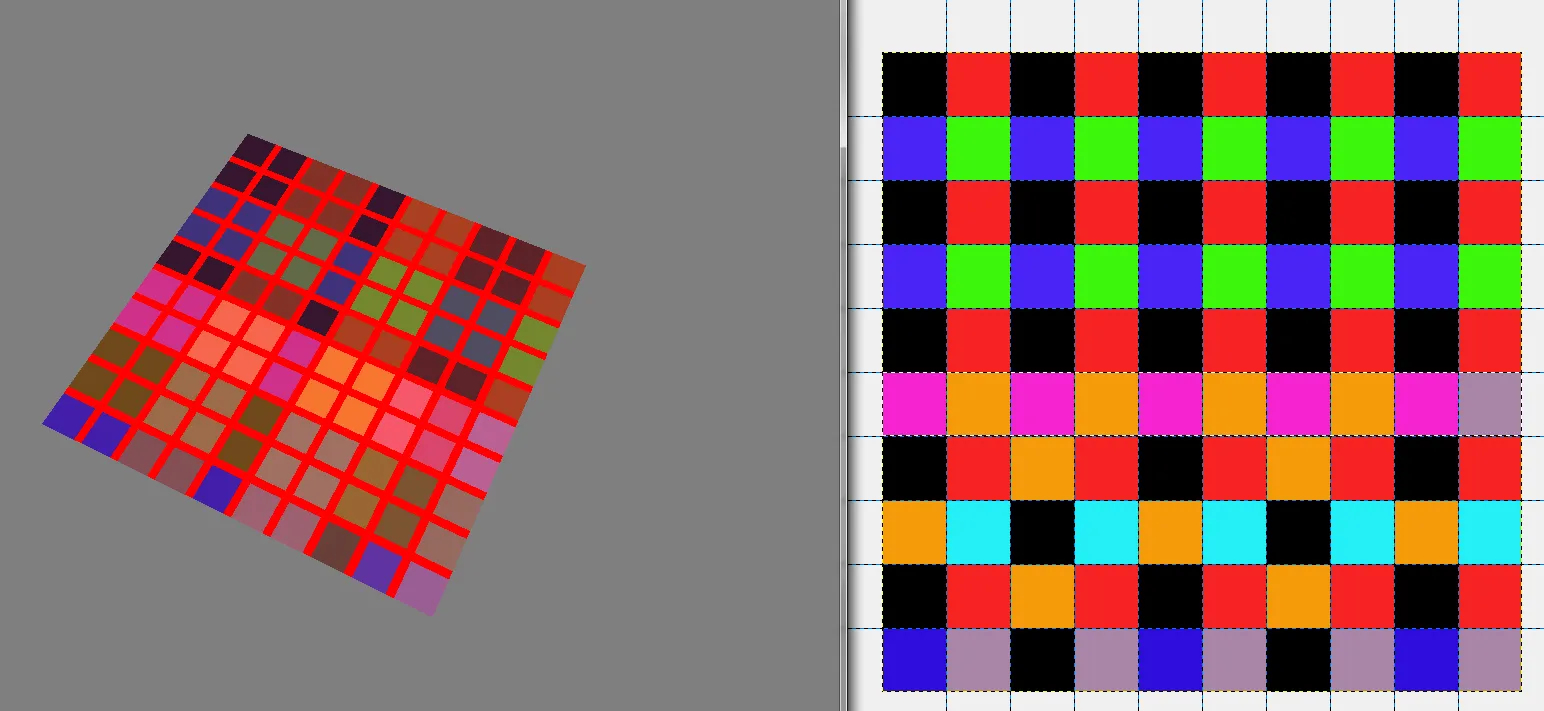我正在使用Ogre3D作为图形引擎。
我手动创建了一个网格,它工作正常,UV坐标是正确的,并且设置为表示网格坐标(对于这个示例,网格为10 x 10)。
我在顶点程序中什么也不做,并且有一个非常简单的片段程序。我已经包含了两个程序以及材料文件来解释。
我的问题是,即使将过滤设置为“无”,颜色似乎也不能与我的原始图像相同(这只是一个测试图像,因为我在手动在ogre中创建纹理时遇到了问题)。事实证明,问题不在于我在ogre中的代码,而更可能是与材质文件或片段/顶点程序有关的问题。
我还在左侧包含了输出的屏幕截图和右侧的原始图像。片段着色器还绘制了一个简单的网格,以便确保UV坐标被正确传递。看起来它们是正确的。

如果您有任何见解,将不胜感激,因为我真的不确定我做错了什么。
材料文件:
// CG Vertex shader definition
vertex_program PlainTexture_VS cg
{
// Look in this source file for shader code
source GameObjStandard.cg
// Use this function for the vertex shader
entry_point main_plain_texture_vp
// Compile the shader to vs_1_1 format
profiles arbvp1
// This block saves us from manually setting parameters in code
default_params
{
// Ogre will put the worldviewproj into our 'worldViewProj' parameter for us.
param_named_auto worldViewProj worldviewproj_matrix
// Note that 'worldViewProj' is a parameter in the cg code.
}
}
// CG Pixel shader definition
fragment_program PlainTexture_PS cg
{
// Look in this source file for shader code
source GameObjStandard.cg
// Use this function for the pixel shader
entry_point main_plain_texture_fp
// Compile to ps_1_1 format
profiles arbfp1
}
material PlainTexture
{
// Material has one technique
technique
{
// This technique has one pass
pass
{
// Make this pass use the vertex shader defined above
vertex_program_ref PlainTexture_VS
{
}
// Make this pass use the pixel shader defined above
fragment_program_ref PlainTexture_PS
{
}
texture_unit 0
{
filtering none
// This pass will use this 2D texture as its input
texture test.png 2d
}
texture_unit 1
{
texture textureatlas.png 2d
tex_address_mode clamp
filtering none
}
}
}
}
CG文件:
void main_plain_texture_vp(
// Vertex Inputs
float4 position : POSITION, // Vertex position in model space
float2 texCoord0 : TEXCOORD0, // Texture UV set 0
// Outputs
out float4 oPosition : POSITION, // Transformed vertex position
out float2 uv0 : TEXCOORD0, // UV0
// Model Level Inputs
uniform float4x4 worldViewProj)
{
// Calculate output position
oPosition = mul(worldViewProj, position);
// Simply copy the input vertex UV to the output
uv0 = texCoord0;
}
void main_plain_texture_fp(
// Pixel Inputs
float2 uv0 : TEXCOORD0, // UV interpolated for current pixel
// Outputs
out float4 color : COLOR, // Output color we want to write
// Model Level Inputs
uniform sampler2D Tex0: TEXUNIT0,
uniform sampler2D Tex1: TEXUNIT1) // Texture we're going to use
{
//get the index position by truncating the uv coordinates
float2 flooredIndexes = floor(uv0);
if((uv0.x > 0.9 && uv0.x < 1.1)
|| (uv0.x > 1.9 && uv0.x < 2.1)
|| (uv0.x > 2.9 && uv0.x < 3.1)
|| (uv0.x > 3.9 && uv0.x < 4.1)
|| (uv0.x > 4.9 && uv0.x < 5.1)
|| (uv0.x > 5.9 && uv0.x < 6.1)
|| (uv0.x > 6.9 && uv0.x < 7.1)
|| (uv0.x > 7.9 && uv0.x < 8.1)
|| (uv0.x > 8.9 && uv0.x < 9.1)) {
float4 color1 = {1.0,0,0,0};
color = color1;
} else if((uv0.y > 0.9 && uv0.y < 1.1)
|| (uv0.y > 1.9 && uv0.y < 2.1)
|| (uv0.y > 2.9 && uv0.y < 3.1)
|| (uv0.y > 3.9 && uv0.y < 4.1)
|| (uv0.y > 4.9 && uv0.y < 5.1)
|| (uv0.y > 5.9 && uv0.y < 6.1)
|| (uv0.y > 6.9 && uv0.y < 7.1)
|| (uv0.y > 7.9 && uv0.y < 8.1)
|| (uv0.y > 8.9 && uv0.y < 9.1)) {
float4 color1 = {1.0,0,0,0};
color = color1;
} else {
//get the colour of the index texture Tex0 at this floored coordinate
float4 indexColour = tex2D(Tex0, (1.0/10)*flooredIndexes);
color = indexColour;
}
}